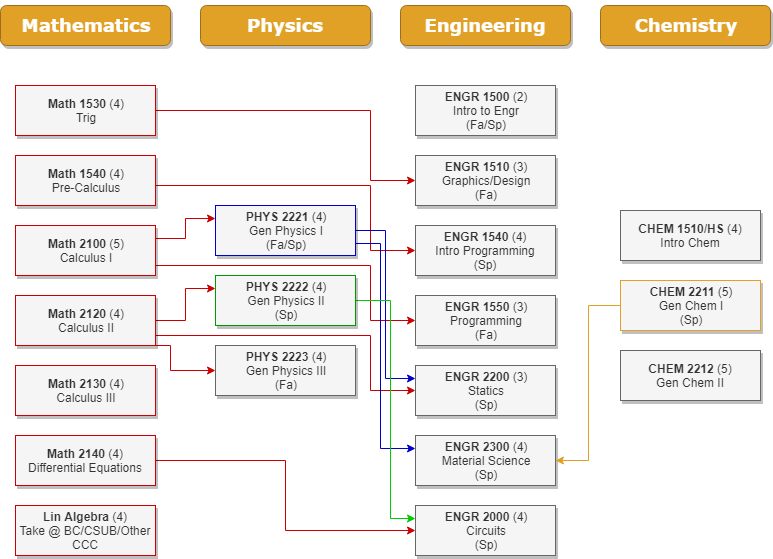Engineering Degree
Description
The Engineering Program offers an Associate in Science in Engineering degree upon successful completion of all requirements. It is designed to provide the foundation courses for a student to successfully complete upper division course work to achieve a Bachelor of Science (B.S.) degree in one of seven engineering disciplines throughout the California State University (CSU) system.
The Program also enables students to launch directly into a career as a technologist or technician upon successful completion of all degree requirements for the Associate in Science in Engineering.
See the Engineering Course Flowchart and your earnings potential, below.
Engineers utilize a variety of technical, mathematical, creative, and problem-solving skills to design, develop, produce, and optimize new products and manufacturing methods. This Program starts the development of these skills and qualifies students for transfer.
The CSU engineering disciplines are:
- Aerospace Engineering
- Civil Engineering
- Computer Engineering
- Electrical Engineering
- Engineering Science
- Manufacturing Engineering
- Mechanical Engineering
See the Associate in Science in Engineering Degree Requirements in the Taft College Catalog. Please note that this link takes you to an external website.
Additional Financial and Academic Support for Engineering Students
The Stanley and Madalyn Hutchison Engineering Promise Program (HEPP) at Taft College has been established to provide financial and academic support for students enrolled in the Taft College Engineering Program. For an application and eligibility requirements, please visit the Engineering-HEPP webpage.
Earnings Potential
An associate of science degree in engineering offers you the salary potential of $32,876 two years after graduation from Taft College, with expected increases to $71,779 by five years, based on five-year studies of graduates by California Community Colleges. These do not reflect salaries with a four-year degree.1
Career options with your Associate of Science in Engineering from Taft College include technologists and technicians. Selected technologist and technician options are listed, with their median annual wage according to the U.S. Bureau of Labor Statistics: $60,220 for industrial engineering; $60,460 for mechanical engineering; $73,580 for aerospace engineering; $58,320 for civil engineering; $63,640 for electrical and electronic engineering; and $48.390 for environmental engineering.2
For those who transfer and successfully complete their B.S. degree in an engineering discipline, these are examples of your earnings potential. The median annual wage is $122,270 for aerospace engineer; $88,050 for civil engineer; and $128,170 for computer engineer.3
1 California Community Colleges Chancellor’s Office. Salary Surfer. 2021. https://salarysurfer.cccco.edu. Accessed 19 April 2023.
2 “Occupational Outlook Handbook.” U.S. Bureau of Labor Statistics. 8 Sept. 2022. www.bls.gov/ooh. Accessed 19 April 2023.
3 “Occupational Outlook Handbook.” 8 Sept. 2022.
Program and Educational Planning
Engineering degrees require intensive math, science, and engineering course curriculum. They are also considered “high unit majors” and may require additional semesters to complete all required coursework. Preparations in high school including pre-calculus, physics, chemistry, and Project Lead the Way (PLTW) curriculum will minimize any additional course workload. Developing an educational plan with Taft College Counseling and Engineering faculty, and meeting with a counselor each semester, are strongly encouraged and highly recommended.
Please note that “Degree Requirements” and the course numbers, listed below, link to the Taft College Catalog, an outside website. Plan to return to the Taft College website and Engineering page.
Engineering and Physics Class Offerings
| CLASS | PREREQUISITE | FALL | SPRING |
| ENGR 1500 | NONE | X | X |
| ENGR 1510 | MATH 1530 | X | |
| ENGR 1540 | MATH 1540 | X | |
| ENGR 1550 | MATH 2100 | X | |
| ENGR 2000 | MATH 2140 (pre/co-req) | X | |
| ENGR 2200 | MATH 2120 and PHYS 2221 | X | |
| ENGR 2300 | CHEM 2211 and PHYS 2221 | X | |
| PHYS 2221 | MATH 2100 (pre/co-req) | X | X |
| PHYS 2222 | PHYS 2221 and MATH 2120 (pre/co-req) | X | |
| PHYS 2223 | PHYS 2222 and MATH 2120 | X |
Program Learning Outcomes
The program is designed to create the following outcomes:
- Student demonstration of critical thinking, creativity, and problem-solving skills as individuals and as team members.
- Demonstrate proper application of foundational engineering, math, and science skills while solving current industry problems.
- Make effective career choices in the engineering field.
Engineering Course Flowchart
